“A good fight should be like a small play, but played seriously. A good martial artist does not become tense, but ready. Not thinking, yet not dreaming. Ready for whatever may come.”
— Bruce Lee, “Enter the Dragon”
AWS appreciates challenges and does rise to them. Given the time and inclination, she will attack a baking challenge (or challenges of other bents should anything interesting present itself), and thrill to its fruition.
She wants success of course, but as discussed in this space before, success — most humbly — is the mere (did I say mere?) act of trying. Failure is not trying at all.
So, what bread cried out as a near-impossible, almost-never-made-in-the-home -kitchen creation, due to…what? Time? Task? The incessant availability of it at nearly every coffeehouse, bakery or grocery store baked good case?
I’m speaking of croissants. My recent fixation on cafe au lait bowls (see blog of 2/13) got me in a French state of mind, and in so doing sent me straight to croissants, those puffy, flaky, buttery crescents that carry the mystique of the near-improbable to make!
Who bakes their own croissants? No one, to my mind. And since AWS — despite her desire to shed it — has an ego built upon conquering challenges. She pressed forth with giving them a try.
Know this — it took two tries to get them right. Croissant-making takes some planning and patience — not so much in ingredients; that list is very simple — but in time. They take some time since there is a folding, rolling and chilling process that must occur several times to acquire those flaky layers. So, after two different stabs at these, I can tell you that considerable hours went into my challenge. And I am not sorry.
My first attempt in February was on a cold day. I believe I understand now why the croissants came out heavy and stiff, looking more like those crescent rolls from a can (I mean no disrespect to Pillsbury, it’s just that a croissant is a different animal). I used too much flour, the dough was too stiff, the day was too cold, my push in rolling and folding was not insistent enough.
I was disappointed. The disappointment settled in and made me both fearful and determined to try again. It took me many nights of sleeping on it to know what I needed to do to rectify my effort.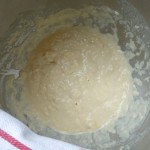
My second try in March came on a warm afternoon with Bruce Lee’s film “Enter the Dragon” playing in the background. With Lee kicking and conquering nearby, I felt certain this time, I could master my dough into the desired consistency for a lovely bread.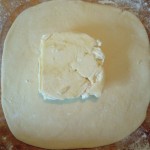
For croissants, as with many yeast breads, you must begin with a sponge, combining flour, water, egg, sugar and yeast to activate the life that gives the bread lift. Once enough flour is added to make the dough pliable, but not too stiff, a good dose of kneading (I used my dough hook) gets the process started. Once you have your dough, you let it rest in the fridge for half an hour.
Now, here I must warn the baker reading and considering the croissant, there are a number of rolling, molding, folding and chilling steps about to begin. So factor your time. A giant butter patty is created with softened butter, flour and salt. Once your dough AND your butter square have chilled, you combine them by enfolding the butter into dough rolled out to a square, then proceed to meld them by first tapping then rolling the dough out.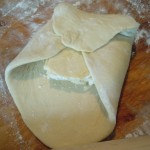
The dough is rolled out, folded like a letter, then folded as if closing a book. Roll it out and do the same again. Chill. Roll out and fold two lore times for a total of four times. So much folding..and it has never been my strong suit. Still, I persisted.
At the fourth folding, the dough could rest overnight in the refrigerator. I was optimistic. This dough had more give and more life than my first batch. I felt sure then that when I formed my croissants the following day, they would rise to heavenly heights.
The feeling was better expressed by Mr. Lee in “Enter the Dragon,” when he tells his student: “Don’t think. FEEL. It’s like a finger pointing at the moon. Do not concentrate on the finger or you will miss all of the heavenly glory! ”
The dough had puffed and risen slightly overnight. I rolled it out into the proper length, then trimmed it, and cut it into into rectangles, then triangles.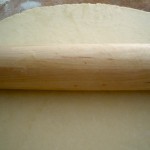
I rolled croissants into their little tight bundles, brushed them with egg wash and let them proof while the oven heated and even past to give them extra air time.
I felt, I did not think. I did not worry about the pointing finger (myself), but the glory of the moon.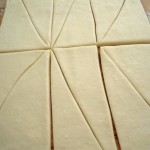
The finished rolls looked right, fuller and airier than my first batch. Upon lifting them, their lightness spoke volumes. Upon tasting, even more was said. The crust was crisp and flaky as a croissant should be, the inside tender and buttery…no condiments needed, but certainly welcome if you so desire. I felt victory, a fight won. A fight? Bruce Lee said his style of fighting was not fighting at all. I understand.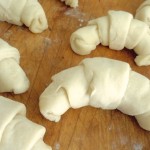
Do I recommend making croissants, when you can easily pick up these puffs anywhere? Yes, if you like to bake, particularly bread of any kind. These are called “Croissant de Boulanger,” a baker’s croissant (but as my friend, ADF suggested, they could be called Kung Fu or Karate Croissants), a bread for those of us who ever see the oven light looming as the moon in the sky. Skill is a mastering of both thought and feeling, but setting them free as well.
Baker’s Croissants
From King Arthur Flour
Dough
2 large eggs plus enough warm water to make 2 cups of liquid (16 ounces)
1/4 cup sugar
5 1/2 to 6 cups unbleached, all-purpose flour
2 1/4 teaspoons instant yeast
1/2 cup nonfat dry milk (optional)
1 scant tablespoon salt
1 teaspoon vanilla extract (optional; for sweet pastry)
2 tablespoons butter, melted
Butter
1 7/8 cups unsalted butter, cool to the touch
3/4 teaspoon salt (omit if using salted butter)
1/2 cup unbleached, all-purpose flour
Directions
1) For the dough: Make a sponge by cracking the eggs into a 2-cup liquid measure and adding enough warm water to equal 2 cups. Beat until blended, and pour into a large mixing bowl. You can also put the sponge into the bucket of your bread machine, set on the dough cycle. Add 1 tablespoon of the sugar, 3 cups of the flour, and the yeast. Mix until well blended. Cover and set aside.
2) For the butter: While the yeast begins its work, set up the butter inlay. Mix the butter and 1/2 cup flour just until the mixture is smooth and well blended (no hard lumps). You can do this with a mixer, a food processor, or with a spoon, by hand. Be careful not to beat the mixture at high speed; you don’t want to incorporate any air. Lightly flour a piece of plastic wrap, place the butter mixture on it, and use a dough scraper to pat it into an 8-inch square. Wrap the butter and put it in the refrigerator on a flat surface for at least 30 minutes.
3) Finish the dough: Stir the vanilla, if using, and the melted butter into the sponge. Whisk together the remaining 2 1/2 cups of the remaining flour, the rest of the sugar, the dry milk, and the salt. Add to the sponge and mix until you have a soft but kneadable dough, either by hand, in your mixer, or using the dough cycle of your bread machine. Check the dough after kneading for 4 to 5 minutes, adding more of the measured flour if the dough is still sticky.
4) Once the dough is smooth and elastic, pat it into a square shape, wrap it loosely and refrigerate it for 30 minutes.
5) Rolling in: Remove the chilled dough from the refrigerator and put it on a lightly floured surface. Gently roll it into a square about 12 inches across. Unwrap the butter slab and place it in the center of the dough at a 45° angle, so it looks like a diamond in the square.
6) Fold the flaps of the dough over the edges of the butter until they meet in the middle. Pinch and seal the edges of the dough together; moisten your fingers with a little water, if necessary.
7) Dust the top with flour, then turn the dough over and tap it gently with the rolling pin into a rectangular shape. Pick up the dough to make sure it isn’t sticking underneath, dusting under with more flour if necessary, then roll from the center out until you have a rectangle 20 inches long by 10 inches wide.
8) When you’ve reached the proper size, take a dry brush and lightly sweep off any excess flour, then fold the bottom third of the dough up to the center, and the top third over that (like a business letter). Line the edges up on top of each other, and even up the corners so they’re directly on top of each other. Take a dab of water if you need to, to tack the corners together. You’ve now made your first “turn.”
9) Turn the dough package 90° to the right, so it looks like a book ready to be opened. If the dough is still cool to the touch and relaxed, do another rolling and turning the same way. Make a note of how many folds you’ve completed and the time, and wrap the dough. Return it to the refrigerator for at least 30 minutes. Repeat the above folding and turning process one more time, for a total of four turns. Once completed, wrap the dough well and refrigerate it for at least an hour, and preferably overnight before using.
10) Shaping the croissants: Using half the dough at a time, roll it to a 12″ x 18″ rectangle. Trim the edges of the dough on every edge using a ruler and pizza wheel. This cuts off the folded edges that would inhibit the “puff.” Cut the dough in thirds lengthwise and in half through the middle. This will give you six 4″ x 9″ pieces. Cut each piece in half diagonally, and arrange them so the points of the triangles are facing away from you. It’s okay to stretch them out gently to elongate them when you do this. Cut a 1/2″ notch in the short edge of the triangle.
11) If you want to, this is the time to place a teaspoon of filling at the base of the triangle. Roll up the dough, starting with the notched edge and working toward the point. Make sure the point is tucked under the bottom of the croissant. If you have to stretch the dough a little to make that happen, it’s okay. You can also use a drop of water on the tip to help it stay in place. Form the crescent by bending the ends toward the center where the tip is tucked underneath. Place the croissants on a lightly greased or parchment-lined baking sheet. Cover and chill for 30 minutes. You could also freeze the unbaked pastries at this point.
12) To bake the croissants: Take the croissants out of the refrigerator, and preheat the oven to 425°F. While the oven is heating, brush the tops of the croissants with an egg well-beaten with 1 tablespoon of water.
13) When the oven is hot, bake the croissants for 15 minutes, then reduce the oven’s temperature to 350°F and bake for another 15 to 20 minutes. The croissants should be a deep golden brown, even where the dough overlaps; you don’t want any raw dough in the center. Remove from the oven and cool on a rack.
Blogger’s Note: I made half this recipe, for 12 croissants total. I allowed at least 20 minutes for the shaped, unbaked croissants to proof at room temperature before baking.
